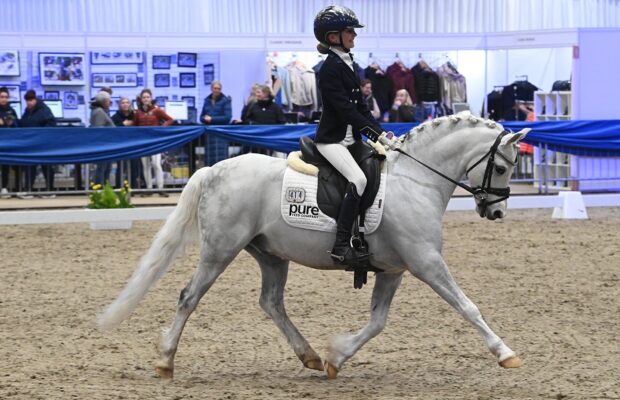Half pass is an advanced form of lateral work for horses. In the half pass the horse moves sideways along the diagonal line, while looking in the direction of movement. The forehand should be slightly ahead of the quarters and the horse should be equally bent through the body from poll to tail. The fluency of the pace should not be interrupted with the normal rhythm, balance, tempo and cadence of the pace maintained.
Performed correctly, the perfect half pass should flow from one side of the arena to the other, with the rider able to sit effortlessly in the saddle.
As tests progress in difficulty up the competitive levels of dressage, so does the angle of the half pass, requiring greater crossing of the legs and gymnastic ability. Half pass can be ridden in both trot and canter.
Half pass should not be attempted until the horse is fully established in both shoulder-in and travers.
Aids for riding half pass

In the half pass the horse moves sideways along the diagonal line, while looking in the direction of movement
The basic aids for lateral work are the same regardless of the movement being performed:
- the rider’s weight should remain in the direction of the movement
- the rider’s inside leg is responsible for bend and forward momentum
- the outside leg controls the amount of sideways movement
- the rider’s inside hand asks for a soft flexion, but never pulls back or crosses over
- the outside hand controls the speed and the amount of bend in the neck
- the rider should look in the direction they are travelling
So to ride half pass to the left, the left leg is on the girth asking the horse to bend to the inside and maintain impulsion. The right leg is behind the girth asking the outside hind leg to step over under the horse’s body and to control the quarters. The left rein is used to ask the horse to flex to the left and remain soft in the jaw. The outside rein is there to prevents the horse from bending too much or rushing forward. The rider’s weight should be directed towards the inside seat bone.
Preparation for the half pass should start before the corner with one or more half halts to help balance your horse. For example, in preparation for left half pass, the rider should sit a little to the left, with their left leg a little forward.
Dressage rider Amy Woodhead: how to ride a good canter half pass
Common mistakes and useful training tips
It is very easy to ride this movement without knowing exactly where the horse’s quarters are. Quarters trailing by a couple of inches can lose you marks, but in the early days of training, not pushing the horse over to become too parallel will gain more freedom of movement.
Trying to achieve too much bend can also encourage the horse to leave the quarters behind. But the biggest mistake is to have the quarters leading. This often happens in the first stride after a change of bend in the canter zig-zag (at grand prix level).
Riding transitions, as well as transitions within the pace, while in half-pass is a useful training exercise. For example, ride half pass (or shoulder-in) going from trot to walk while still travelling sideways and then go back to trot again. Working in collected trot to working trot and then medium trot and back again to collected trot will help improve the gaits while still travelling sideways.
In the grand prix, the zig-zag movement in canter requires three strides left then six right, six left, six right and three left, back to the centre line. The marks for this movement are doubled. Not only is the half pass in canter, but the rider also needs to count the strides accurately.
This is where you need the ability to change the bend a stride early, as this movement comes very fast. In earlier tests, the movement comes during the trot work and, here, the training for the preparation and changes of direction really show. Quarters trailing will become quarters leading. A zig-zag also exposes the weakness of a one-sided horse.
At what level is half pass found in British Dressage tests?
The movement can be found tests of medium level and above under British Dressage rules, while it is first seen in British Eventing tests at advanced level.
You might also be interested in:

Understanding leg yield and how to ride it to improve your horse’s suppleness

3 easy steps to nailing the perfect dressage-ready canter
Horse & Hound's dressage editor Alice Collins, who is currently competing at prix st georges level, shares her simple steps

Subscribe to Horse & Hound magazine today – and enjoy unlimited website access all year round
Horse & Hound magazine, out every Thursday, is packed with all the latest news and reports, as well as interviews, specials, nostalgia, vet and training advice. Find how you can enjoy the magazine delivered to your door every week, plus options to upgrade your subscription to access our online service that brings you breaking news and reports as well as other benefits.




